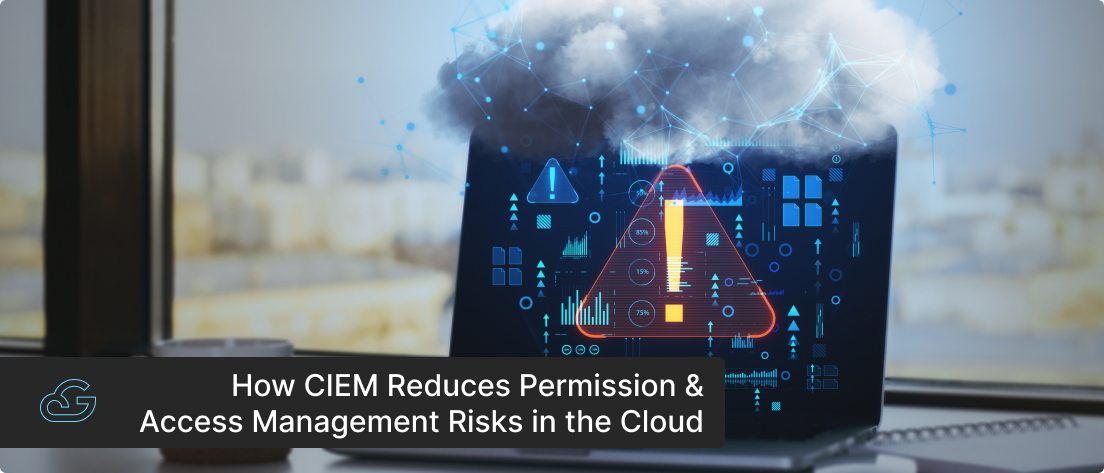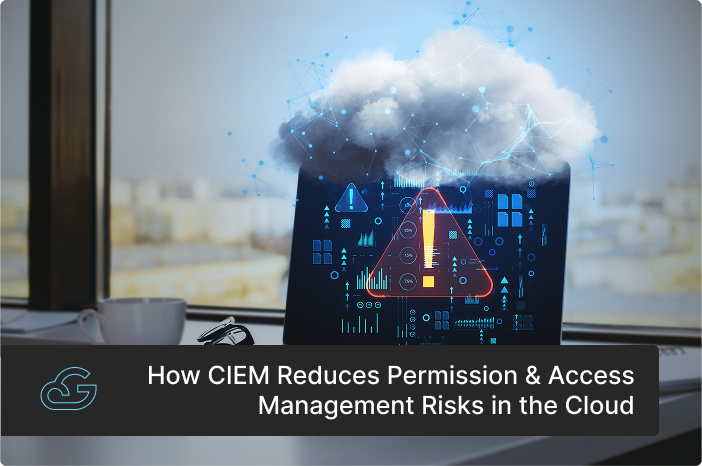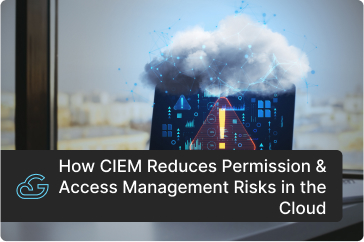Blogs / Cloud Security
How CIEM Reduces Permission & Access Management Risks in the Cloud
By
Siju Vincent
Posted: March 25, 2025
• 8 Minutes
Identity-based attacks in the cloud are on the rise, with stolen or compromised credentials being a primary attack vector. As a result, identity has become the new perimeter in cloud security. The growing adoption of multi-cloud architectures complicates identity and access management (IAM). Organizations now operate across multiple cloud providers, requiring security teams to manage thousands of entitlements - permissions granted to identities (both human and non-human) that define their level of access to cloud resources. These entitlements, if misconfigured or excessive, can be exploited by attackers to gain unauthorized access, escalate privileges, and move deeper into cloud environments.
According to Gartner, by 2025, 99% of cloud security failures will be caused by misconfigurations on the customer’s end, highlighting the urgent need for better access governance. To address the cloud entitlement challenges., Cloud Infrastructure Entitlement Management (CIEM) has emerged as a critical security solution. In this article, we will explore the core capabilities of CIEM, its benefits, and how it strengthens cloud security by reducing access risks in complex, multi-cloud environments.
Tips 
What are Human identities?
Human identities are user accounts assigned to individuals, granting them access to cloud resources based on their roles and permissions.
What are Non-human identities?
Non-human identities are machine-based accounts, including applications, services, and automated processes, that require permissions to interact with cloud environments.
What does Entitlement mean in the cloud?
Entitlement in the cloud refers to the permissions and access rights granted to identities (users, applications, and services) within the infrastructure. It defines who can access what resources and what actions they can perform.
What is CIEM (Cloud Infrastructure Entitlement Management)
Cloud Infrastructure Entitlement Management (CIEM) is a set of tools and methodologies that enable organizations to manage and enforce access rights, permissions, and entitlements across cloud environments, making it an integrated approach to security. By leveraging automation, CIEM continuously identifies and corrects excessive or misconfigured entitlements. This reduces the risk of unintentionally granting excessive permissions and ensures more efficient access control.
Comparing CIEM with other cloud identity and access management solutions helps you better understand its role in cloud security management. Let's explore how they differ in their functions.
Why CIEM is Essential for Managing Cloud Security
In cloud environments, especially multi-cloud setups, your security teams need to manage entitlements for human identities while handling tens of thousands of non-human identities. At the same time, as cloud deployments and infrastructures expand, the need for access control entitlements grows, creating a widening permissions gap between users, applications, and systems. If not properly managed, this gap increases the attack surface, making your cloud environments more vulnerable.
Let's examine the common challenges in cloud entitlement management that can be resolved by CIEM.
-
# Challenge 1: Limitations of Traditional IAM & PAM
Traditional IAM and PAM solutions struggle to manage the dynamic, distributed nature of modern cloud environments, often lacking granular visibility into enterprise entitlements. CIEM overcomes these limitations by providing detailed control over cloud entitlements, permissions, and configurations, thereby reducing the risk of misconfigurations and an expanded attack surface.
-
# Challenge 2: Dynamic Access Control
Cloud resources such as virtual machines, storage, and serverless functions are provisioned and de-provisioned on demand. This dynamic nature necessitates mechanisms for continuous visibility, monitoring, and real-time access adjustments. CIEM automates access governance, ensuring permissions are granted and revoked dynamically as resource requirements change.
-
# Challenge 3: Privileged Access Risks
Overprivileged accounts grant users and services more access than necessary, increasing the risk of insider threats and external attacks. For instance, developers may need special access to debug applications or manage workflows in the CI/CD pipeline for testing and deployment. This increases security risks if permissions are not managed properly. CIEM enforces least-privilege policies, and policy-driven access controls that allow rapid yet safe deployment, restricting access to only what is necessary.
-
# Challenge 4: Decentralized IAM Policies
Each cloud service provider (such as AWS, GCP, and Azure) has its own IAM framework with different features and configurations. In large organizations, decentralized, IAM management by individual teams can create security gaps and lead to inconsistent policies. CIEM centralizes and standardizes access controls across multi-cloud environments, ensuring consistent security policies and reducing misconfigurations.
-
# Challenge 5: Visibility & Compliance Management
Multi-cloud environments are often spread across different regions, each with unique governance requirements and security frameworks. This complexity makes it challenging to maintain centralized visibility into entitlements and ensure compliance with standards like GDPR, HIPAA, and SOC 2. CIEM addresses this challenge by providing real-time monitoring, centralized tracking of permissions, and automated reporting. This ensures that organizations can meet regulatory and security standards efficiently, even in highly dynamic and distributed cloud environments.
How CIEM Simplifies Cloud Permission & Access Management
Cloud Infrastructure Entitlement Management (CIEM) plays a critical role in mitigating access risks by continuously monitoring and enforcing least-privilege access across multi-cloud environments. Excessive permissions are a common security vulnerability, often resulting from over-provisioning, misconfigurations, or a lack of visibility into entitlements. CIEM helps security teams regain control by efficiently detecting, managing, and remediating these risks. Here’s how:
-
Continuous Discovery and Inventory of Entitlements
CIEM solutions provide real-time visibility into all identities, permissions, and resources across cloud environments, including:
- Human users (employees, third-party contractors)
- Non-human identities (service accounts, APIs, CI/CD pipelines, bots)
- Shadow identities and orphaned accounts
For instance, your cloud-based application needs integration with multiple third-party APIs. Over time, service accounts with excessive privileges remain active even after their use is discontinued. CIEM detects these unused or high-risk accounts and alerts security teams to revoke or adjust their permissions.
-
Automatic Detection of Overprivileged Accounts
One of the key challenges in multi-cloud environments is the allocation of unnecessary permissions. CIEM leverages entitlement mapping and analytics to detect and flag accounts with excessive privileges. This ensures that permissions are only granted based on actual usage patterns.
Imagine a scenario where your developer is granted admin access to a cloud database for debugging but forgets to revoke it afterward. CIEM identifies this anomaly and suggests a rollback to least-privileged access, reducing the attack surface.
-
Enforcement of Least-Privilege Access (LPA)
CIEM continuously analyzes access behaviors to enforce the Principle of Least Privilege (PoLP). It recommends adjustments by removing unused or unnecessary permissions and reduces exposure to insider threats and external attacks.
Let’s understand how CIEM enforces PoLP with a simple example. Suppose a cloud engineer is granted full administrative access to a Kubernetes cluster during the initial setup phase. Once the setup is complete, their role only requires read-only access for monitoring purposes. CIEM detects this change in usage and automatically revokes unnecessary permissions. This makes sure that the engineer retains only the access needed.
-
Cross-Cloud Policy Standardization and Controls
Managing access policies in multi-cloud environments can be complex due to the differing Identity and Access Management (IAM) models across platforms like AWS, Azure, and GCP. CIEM simplifies this by unifying policy enforcement, ensuring that security best practices are applied consistently across all cloud environments.
For example, if your organization uses both AWS and GCP and an employee has administrator access in AWS but only minimal permissions in GCP, CIEM detects this discrepancy. It then standardizes access policies across both platforms, ensuring consistency, reducing security gaps, and preventing unintended privilege escalation.
-
Anomalous Activity Detection and Response
CIEM integrates User and Entity Behavior Analytics (UEBA) to monitor entitlement usage in real-time. If an identity performs suspicious actions—such as accessing unauthorized resources or escalating privileges—it triggers alerts and automated responses.
That means if a machine identity starts accessing sensitive financial records outside of normal working hours. CIEM flags this behavior as a potential compromise, alerts the security team, and initiates an automated lockdown of the account.
-
Just-In-Time (JIT) Access Controls
Instead of permanently granting high-level permissions, CIEM supports Just-In-Time (JIT) access, which provides time-bound, approval-based privileges when needed. This prevents users and service accounts from retaining unnecessary privileges.
Let’s make this clear with a DevOps scenario. Suppose a DevOps engineer needs temporary write access to an S3 bucket for a specific deployment. CIEM grants the required permissions for a predefined duration and automatically revokes them once the task is completed. This will help you prevent unnecessary privilege retention and reduce security risks.
-
Automated Remediation and Policy Enforcement
CIEM doesn’t just detect issues - it automates remediation by revoking excessive permissions, applying policy corrections, and generating compliance reports. This reduces manual workload and ensures cloud environments remain secure.
For example, a former employee’s access remains active due to a misconfigured offboarding process. CIEM detects the inactive user and automatically disables access to prevent potential security breaches.
Implementing CIEM delivers a wide range of benefits for your business. By providing granular visibility into permissions and automating access governance, CIEM helps organizations reduce risks, optimize costs, and maintain a strong security posture. Let’s explore these advantages in detail to understand how CIEM can transform your cloud security strategy.
Key CIEM Features to Enhance the Security of Your Cloud Infrastructure
With the growing need for sophisticated entitlement management, numerous CIEM solutions have emerged, each designed to provide better visibility, control, and automation. Whether managing multi-cloud environments, enforcing least privilege, or ensuring compliance, the right CIEM tool should offer robust capabilities to meet the business challenges. Let’s learn the core features of CIEM and how they enhance cloud security.
-
Comprehensive Asset Visibility
- Identifies all cloud resources, including users, workloads, storage, and network configurations.
- Maintains a clear inventory to track and manage entitlements across multi-cloud environments.
-
Unified Access Management
- Centralizes permission control across AWS, Azure, GCP, and other cloud providers.
- Simplifies monitoring and management of user and non-user access to critical resources.
-
Advanced Auditing & Compliance Reporting
- Logs all access-related activities, including permission changes and policy violations.
- Provides audit-ready reports to support compliance with regulatory frameworks.
-
Multi-Cloud Policy Regularization
- Unifies IAM policies across multiple cloud platforms for consistent security enforcement.
- Prevents misconfigured permissions and privilege mismatches across different environments.
-
Anomaly Detection & Behavior Analytics
- Utilizes User and Entity Behavior Analytics (UEBA) powered by AI and machine learning to analyze user and entity activities.
- Detects deviations from normal behavior patterns to identify threats such as privilege escalation, insider risks, and account takeovers.
-
Integration with IAM and Security Tools
- Connects with IAM, PAM, and CSPM solutions for comprehensive security governance.
- Ensures consistent enforcement of security policies across all cloud services.
-
Automated Entitlement Management
- Continuously analyzes entitlements to identify unused, excessive, or risky permissions.
- Automatically detects and remediates risks by revoking or modifying unnecessary access rights.
-
Integration with Cloud-Native Application Protection Platform (CNAPP)
- Enhances cloud security by combining CIEM with workload protection, runtime security, and compliance enforcement.
- Provides identity-driven threat detection and risk mitigation within a unified cloud-native security framework.
Choosing the Right CIEM Solution for Your Use Case
The right CIEM solution makes cloud entitlement management easy and intuitive. The table below outlines some use-case scenarios where CIEM solutions can be applied. Understanding them will help you choose the best solution for your security strategy.
Strengthening Cloud Security with Expert CIEM Consulting from Gsoft
Selecting the right CIEM solution is critical to efficiently address the risks associated with excessive cloud permissions. With the growing complexity of multi-cloud environments, a one-size-fits-all approach simply doesn’t work. Also, the ideal CIEM solution should align with your organization’s specific needs, whether it’s granular visibility into permissions, automated remediation, or compliance with industry regulations.
While there are many CIEM solutions available in the market, choosing the one that perfectly matches your requirements can be challenging, and it requires careful consideration and expert guidance. Gsoft’s cloud security consulting services guide you through this decision-making process. From assessing your requirements to implementing the best CIEM solution, we provide end-to-end security consulting to ensure your cloud environment is secure, compliant, and optimized for success. Contact our Gsoft Cloud Security Experts today to find the perfect CIEM solution tailored to your needs.


Get Know More About Our Services and Products
Reach to us if you have any queries on any of our products or Services.











